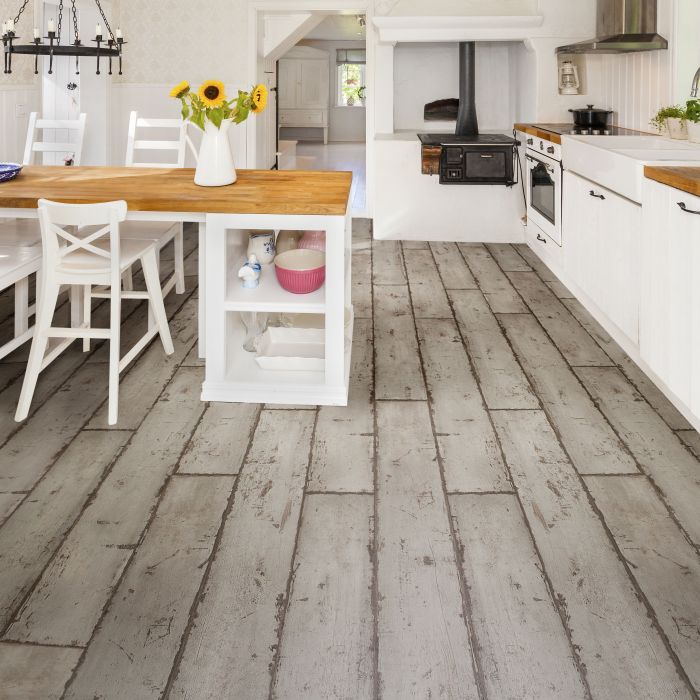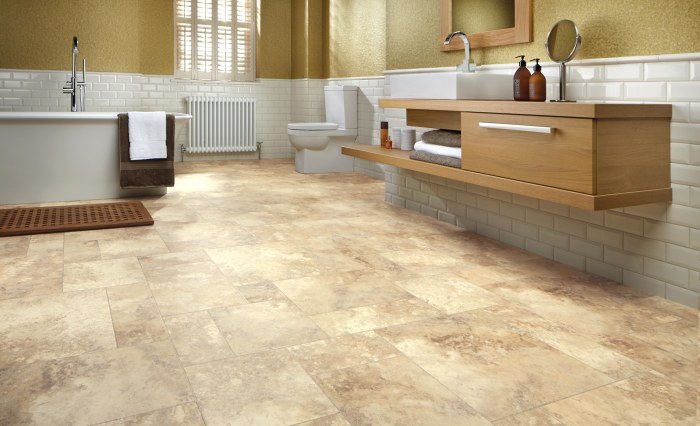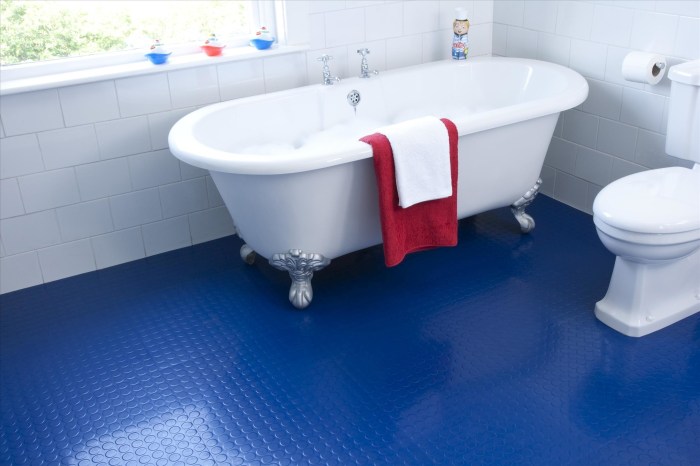Step into a world of elegance and functionality with waterproof vinyl flooring, the perfect solution for bathrooms. Combining durability, water resistance, and ease of maintenance, this flooring option elevates your bathroom experience, transforming it into a sanctuary of style and comfort.
Whether you seek a classic allure or a contemporary flair, waterproof vinyl flooring offers a diverse range of designs and textures. Its versatility complements any bathroom décor, enhancing the overall aesthetic while providing exceptional performance.
Types of Waterproof Vinyl Flooring
Waterproof vinyl flooring is a versatile and durable option for bathrooms, providing a stylish and functional surface that can withstand moisture and spills. Here’s a comprehensive overview of the types of waterproof vinyl flooring available:
Vinyl flooring is constructed with multiple layers, including a backing, core, and top wear layer. The backing provides stability and support, while the core determines the flooring’s thickness and durability. The top wear layer is responsible for protecting the flooring from wear and tear and is where the waterproof properties come into play.
Luxury Vinyl Tiles (LVT)
- LVT planks and tiles are made of multiple layers of vinyl, with a core that is typically made of rigid PVC or a combination of PVC and wood. The top wear layer is made of a durable material such as urethane or ceramic.
- LVT is known for its realistic wood or stone look and feel, making it a popular choice for bathrooms that want the appearance of natural materials without the maintenance.
Sheet Vinyl
- Sheet vinyl is a continuous sheet of vinyl that is installed in one piece, eliminating the need for grout lines. It is made of a flexible PVC material and has a wear layer that is typically thicker than LVT.
- Sheet vinyl is waterproof and easy to clean, making it a good choice for busy bathrooms.
Vinyl Plank Flooring (VPF)
- VPF is similar to LVT but comes in longer, wider planks that resemble hardwood flooring. It is made of a rigid core and has a top wear layer that is typically made of urethane or ceramic.
- VPF is waterproof and durable, making it a good choice for bathrooms that get a lot of foot traffic.
Benefits of Waterproof Vinyl Flooring in Bathrooms
Waterproof vinyl flooring offers numerous advantages for bathroom applications, making it an ideal choice for these wet environments.
Its exceptional durability ensures resistance to scratches, dents, and wear, ensuring longevity even in high-traffic areas. Furthermore, its waterproof nature provides peace of mind, preventing damage caused by moisture and spills.
Ease of Maintenance
Maintaining waterproof vinyl flooring in bathrooms is a breeze. Its smooth surface resists dirt and grime accumulation, requiring only regular sweeping or mopping. Its waterproof properties eliminate the need for harsh cleaning chemicals, making it a low-maintenance flooring solution.
Installation Considerations
Installing waterproof vinyl flooring in bathrooms is a relatively straightforward process, but it does require some preparation and attention to detail. Here’s a step-by-step guide to help you achieve a successful installation:
Before you begin, ensure the subfloor is level, smooth, and dry. Any unevenness or moisture can compromise the installation and lead to problems down the road. If necessary, level the subfloor using a self-leveling compound or by sanding down any high spots.
Subfloor Preparation
The first step in installing waterproof vinyl flooring is to prepare the subfloor. This involves ensuring that the subfloor is level, smooth, and dry. Any unevenness or moisture can compromise the installation and lead to problems down the road.
- If the subfloor is not level, you can use a self-leveling compound to smooth it out.
- If the subfloor is not smooth, you can sand down any high spots.
- If the subfloor is not dry, you can use a moisture meter to check the moisture content. If the moisture content is too high, you will need to wait until the subfloor has dried before installing the flooring.
Adhesive Selection
Once the subfloor is prepared, you will need to choose an adhesive to install the vinyl flooring. There are two main types of adhesives that can be used for waterproof vinyl flooring: pressure-sensitive adhesives (PSA) and wet-set adhesives.
- PSA is a type of adhesive that is applied to the back of the vinyl flooring and then pressed into place. This type of adhesive is easy to use and does not require any special tools.
- Wet-set adhesives are a type of adhesive that is applied to the subfloor and then the vinyl flooring is placed on top of the adhesive. This type of adhesive is more permanent than PSA and provides a stronger bond.
Cutting Techniques
Once you have chosen an adhesive, you will need to cut the vinyl flooring to fit the room. There are two main ways to cut vinyl flooring: using a utility knife or a circular saw.
- A utility knife is a good option for cutting small pieces of vinyl flooring. To use a utility knife, score the vinyl flooring along the desired cut line and then snap it apart.
- A circular saw is a good option for cutting large pieces of vinyl flooring. To use a circular saw, set the blade to the desired depth and then cut along the desired cut line.
Tips and Tricks
Here are a few tips and tricks for installing waterproof vinyl flooring in bathrooms:
- Start by installing the vinyl flooring in the center of the room and work your way out towards the edges.
- Use a roller to press the vinyl flooring into place and remove any air bubbles.
- Allow the adhesive to dry completely before walking on the floor.
Maintenance and Care
Maintaining waterproof vinyl flooring in bathrooms is a breeze. Here’s how to keep it looking its best for years to come.
Regular cleaning is key. Use a damp mop or cloth with a mild cleaning solution. Avoid harsh chemicals or abrasive cleaners, as these can damage the finish.
Disinfecting
To disinfect the flooring, add a cup of white vinegar to a gallon of water. Mop the floor as usual and let it air dry.
Protecting from Wear and Tear
Place mats or rugs in high-traffic areas to protect the flooring from scratches and dents. Use furniture pads under heavy items to prevent indentations.
Maintenance Schedule
For optimal performance, follow this maintenance schedule:
- Daily: Sweep or vacuum to remove loose dirt and debris.
- Weekly: Mop the floor with a mild cleaning solution.
- Monthly: Disinfect the floor with a vinegar solution.
- Annually: Apply a floor polish or protectant to enhance durability.
Design and Aesthetics
Waterproof vinyl flooring for bathrooms offers a vast array of design options, allowing you to customize your bathroom to match your personal style and complement the existing décor. From classic wood looks to modern tile patterns, there’s a flooring option to suit every taste.
Colors
Vinyl flooring comes in a wide range of colors, from light and airy neutrals to bold and vibrant hues. Neutral colors like beige, gray, and white create a clean and sophisticated look, while darker colors like black or navy can add drama and depth to the space.
You can also find vinyl flooring in various shades of blues, greens, reds, and yellows to create a unique and eye-catching bathroom.
Patterns
In addition to solid colors, waterproof vinyl flooring is available in a variety of patterns, including wood-look planks, tile-look squares, and geometric designs. Wood-look vinyl flooring is a popular choice for bathrooms because it offers the warmth and beauty of real wood without the drawbacks of moisture damage.
Tile-look vinyl flooring is another great option for bathrooms, as it is easy to clean and maintain. Geometric designs can add a touch of personality and style to your bathroom.
Textures
Vinyl flooring is also available in a variety of textures, from smooth and glossy to rough and textured. Smooth and glossy vinyl flooring is easy to clean and maintain, making it a good choice for busy bathrooms. Rough and textured vinyl flooring can add visual interest and depth to the space.
You can also find vinyl flooring with embossed textures that mimic the look of natural materials like wood or stone.
Cost and Budget
Installing waterproof vinyl flooring in bathrooms can vary in cost depending on several factors. Understanding these factors and budgeting accordingly can help you plan for a successful project.
Material Costs
The type of vinyl flooring you choose will significantly impact the cost. Luxury vinyl tiles (LVT) and vinyl planks (LVP) are generally more expensive than sheet vinyl, but they offer a wider range of styles and textures.
Size and Coverage
The size of your bathroom and the amount of flooring needed will also affect the cost. Larger bathrooms will require more materials, increasing the overall expense.
Installation Costs
Professional installation is recommended for waterproof vinyl flooring. The cost of installation will depend on the complexity of the job and the installer’s rates.
Tips for Budgeting
- Consider sheet vinyl for a more budget-friendly option.
- Look for sales and discounts on materials.
- Get multiple quotes from installers to compare costs.
- DIY installation can save money, but only if you have the necessary skills.
Environmental Considerations
Waterproof vinyl flooring has raised concerns regarding its environmental impact, primarily due to the use of synthetic materials and manufacturing processes.
The production of vinyl flooring involves the use of polyvinyl chloride (PVC), a type of plastic derived from fossil fuels. PVC is known to release harmful chemicals into the environment during its production and disposal. Additionally, the manufacturing process often requires the use of energy-intensive processes, such as extrusion and calendering.
Sustainable Options
Recognizing the environmental concerns, manufacturers have developed more sustainable options for waterproof vinyl flooring. These options typically use recycled materials, such as post-consumer plastic or wood fibers, in their construction. Additionally, some manufacturers have adopted eco-friendly manufacturing practices, such as using renewable energy sources and reducing waste.
When selecting waterproof vinyl flooring for your bathroom, consider opting for products that are certified by third-party organizations, such as the FloorScore or GreenGuard certifications. These certifications indicate that the product meets certain environmental standards, ensuring that it does not release harmful emissions into the indoor environment.
Case Studies and Examples
Witness the transformative power of waterproof vinyl flooring in bathrooms through real-world examples that showcase its functionality and aesthetic appeal.
From before-and-after transformations to glowing testimonials, these case studies provide a comprehensive understanding of the practical applications and benefits of this innovative flooring solution.
Successful Installation in a Master Bathroom
In a luxurious master bathroom renovation, waterproof vinyl flooring in a rich oak finish was installed throughout the space, creating a warm and inviting ambiance. The flooring seamlessly integrated with the modern fixtures and elegant marble countertops, resulting in a cohesive and stylish design.
The homeowners raved about the flooring’s durability and ease of maintenance, particularly in the moisture-prone areas around the shower and vanity.
Before-and-after photos vividly demonstrate the remarkable transformation, showcasing the flooring’s ability to enhance the bathroom’s aesthetics and functionality.
Last Recap
With waterproof vinyl flooring, you not only invest in a flooring solution but also in the longevity and beauty of your bathroom. Its exceptional qualities ensure a space that remains pristine and inviting, a testament to your discerning taste and commitment to creating a home that inspires.



